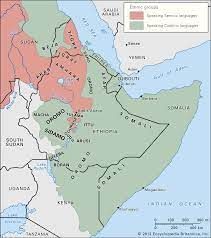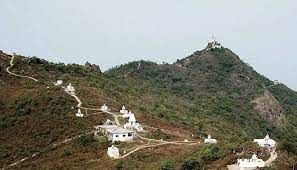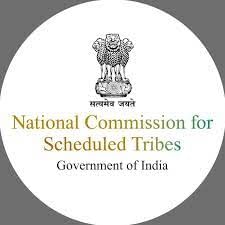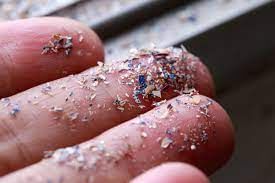UPSC Daily Current Affairs- 4th January 2023 | Current Affairs & Hindu Analysis: Daily, Weekly & Monthly PDF Download
GS-I
Sammed Shikharji Jain Temple and Shetrunjay hill
Context
Members of the Jain community have been staging protests in many states including Delhi for the past two weeks over demands related to two holy sites — Sammed Shikhar on Parasnath hill in Jharkhand and Shetrunjay hill in Palitana of Gujarat.
About Sammed Shikharji Jain Temple:
- Shikharji, often spelled Sammed or Sammet Shikharji, is a holy place in the Indian state of Jharkhand’s Giridih district.
- The highest mountain in the state of Jharkhand, Parasnath Hill, is where it is situated.
- Both Digambara and Svetambara consider it to be the most significant Jain Tirtha (pilgrimage destination), as it is the location where twenty of the twenty-four Jain tirthankaras, together with numerous other monks, obtained Moksha.
- The Jnatrdharmakatha, one of the twelve fundamental texts of Jainism, has the first mention of Shikharji as a Tirth (place of pilgrimage).
- The Parsvanathacarita, a biography of Prva written in the eleventh century, also makes mention of Shikharji.
- An illustration of Parshavanatha’s nirvana at Shikharji can be seen in a palm-leaf manuscript of the Kalpa Stra and Kalakacaryakatha from the thirteenth century CE.
- In 1768 CE, Jagat Seth rebuilt the temples at Shikharji to their present configuration.
- The 1678 CE date is written in Sanskrit at the bottom of the image.
- There is a Bhomiyaji temple at the foot of Shikharji (Taleti).
- There is a mural painting of every temple on Parasnath Hill on the walls of the Jain temple in the village of Madhuban.
- The earliest temple to hold a Bhaktamara Stotra yantra is the Svetambara Bhaktamara temple, founded by Acharya Ramchandrasuri.
About Shetrunjay Hill:
- The hills are located in Palitana city of Bhavnagar district in Gujarat.
- The hills are located on the banks of river Shetrunji and are considered as a sacred hill by Jains.
- The hills are bounded by the Gulf of Khambhat in the south and Bhavnagar town in the north.
- Shatrunjaya translates to Place of Victory.
- The temples atop this hill is said to have been built more than 900 years ago, and are grouped into enclosures.
- Jains believe that Adinath, who is the founder of Jainism, had meditated beneath the tree at the summit of this place.
- The temple complex here also has a shrine of a Muslim saint, Angar Pir.
- The most important temple of all here is the Adinath Temple, located on the highest point of the place.
About Shetrunji River:
- It is an eastward-flowing river in Gujarat. The river rises in the northeast of Gir Hills. The river has a maximum length of 227 kilometres.
Source: Indian Express
Horn of Africa

Context
According to a UNICEF recent publication, nearly 70 per cent of the Intergovernmental Authority on Development (IGAD) region comprise arid and semi-arid lands prone to recurrent droughts in the horn of Africa.
About Horn of Africa:
- The Horn of Africa (alternatively Northeast Africa, and sometimes Somali Peninsula) is a peninsula of East Africa that juts for hundreds of kilometers into the Arabian Sea, and lies along the southern side of the Gulf of Aden.
- It is the easternmost projection of the African continent.
- It indeed resembles in outline the horn of an animal — perhaps especially, the horns of the Black Rhinoceros, whose historic range includes parts of Ethiopia:
- The angle between its northern and south eastern coasts approximates that at the tip of the rhino’s upper horn.
- The concavity of its northern coast, and convexity of its southern, echo similar curvatures on the rhino’s lower horn.
- The term also refers to the greater region containing the countries of Djibouti, Ethiopia, Eritrea and Somalia. As such, it covers approximately 2,000,000 km² and is inhabited by about 86.5 million people.
- Sudan and Kenya are sometimes included as well.
- The Horn of Africa is a UNESCO Biodiversity Hotspot and one of the two entirely arid ones.
- However the Horn of Africa suffers largely from overgrazing and only 5% of its original habitat still remains.
Geography and climate
- The Horn of Africa, almost equidistant from the Equator and the Tropic of Cancer, is an arid region.
- Socotra is a small island off the coast of Somalia, in the Indian Ocean, that is considered to be part of Africa. Its size is 3,600 square km. It is a territory of Yemen, the southernmost country on the Arabian peninsula.
Economy: States of the region depend largely on a few key exports:
- Sudan: Cotton 50% of total exports.
- Ethiopia: Coffee 80% of total exports.
- Somalia: Bananas and livestock over 50% of total exports.
Source: DownToEarth
GS-II
What is National Commission for Scheduled Tribes?
Context
National Commission for Scheduled Tribes recently said that Forest (Conservation) Rules (FCR) 2022 will invariably violate the Forest Rights Act, 2006.
About National Commission for Scheduled Tribes:
- Established in: 2004.
Constitutional Provisions:
- It was established by amending Article 338 and inserting a new Article 338A in the Constitution through the Constitution (89th Amendment) Act, 2003.
- By this amendment, the erstwhile National Commission for Scheduled Castes and Scheduled Tribes was replaced by two separate Commissions namely-
- the National Commission for Scheduled Castes (NCSC), and
- the NCST w.e.f. 19 February, 2004.
What is the composition of the National Commission for Scheduled Tribes?
- The term of office of Chairperson, Vice-Chairperson and each member is three years from the date of assumption of charge.
- The Chairperson has been given the rank of Union Cabinet Minister, and the Vice-Chairperson that of a Minister of State and other Members have the ranks of a Secretary to the Government of India.
What are the functions of the National Commission for Scheduled Tribes (Under Clause (5) of Art. 338A)?
- To Monitor safeguards provided for STs under the Constitution or under other laws;
- To inquire into specific complaints relating to Rights & Safeguards of STs;
- To advise in the Planning Process relating to Socio-economic development of STs;
- To submit report to the President annually and other times on welfare Measures required related to Socio-economic development of STs;
- To discharge such other functions in relation to STs as the President may by rule specify;
Source: Indian Express
Asian Pacific Postal Union (APPU)
Context
India is set to take over leadership of the Asian Pacific Postal Union after successful elections held during the 13th Congress held in Bangkok.
What is APPU?
- Asian Pacific Postal Union (APPU) is an intergovernmental organization of 32 member countries of the Asian-Pacific region.
- It is the only Restricted Union of the Universal Postal Union (UPU) in the region, which is a specialized agency of the United Nations.
- Goal: To extend, facilitate and improve postal relations between member countries and to promote cooperation in the field of postal services.
- As the regional centre for various UPU projects, it also takes the lead in ensuring that all technical and operational projects of the UPU are fulfilled in the region so that the region is integrated into the global postal network in the best possible way.
- The APPU is made up of the three bodies
- Congress: It is the supreme organ of the Union and meets not later than 2 years after the UPU congress
- Executive Council: It comprises all members and meets every year to ensure the work of the union.
- APPU Bureau: It serves as a body for liaison, information, inquiry and training for members.
- Secretary General leads the activities of the Union and is also the Director of the Asian Pacific Postal College (APPC) which is the largest intergovernmental postal training institute in the region.
Source: The Hindu
GS-III
Microplastics
Context
Scientists from South Korea have developed a new water purification system that can quickly and efficiently filter out microplastics. Crucially, the polymer used is relatively inexpensive with excellent adsorption performance and good photothermal properties.
About Microplastics:
- Microplastics are those particles with less than 5 millimeters (0.2 inches).
- There are two types:
- primary microplastics and
- secondary microplastics
- Primary microplastics are directly designed for commercial purposes:
- Nurdles: small pellets that put together, melted and molded to make larger plastic shapes;
- Microbeads: which are used in personal care products to help scrub off dead skin;
- Fibers: many clothes today are made of synthetic plastic fibres like nylon and polyethylene terephthalate (PET).
- Secondary microplastics are formed as large, original plastic pieces break down into millions of smaller pieces.
Major sources of Microplastics:
- Plastic materials are either originated at land or at the ocean.
- Around 70-80% of ocean plastics have land-based sources, while 20-30% of plastics come from marine sources.
- Of the plastic materials coming from marine sources, half is estimated to be caused by fishing fleets that leave behind fishing nets, lines, ropes, and sometimes abandoned vessels.
- Regarding land waste, discarded plastic materials enter the marine environment as trash, industrial discharge, or litter via inland waterways, wastewater outflows, and wind transport.
- While 25% of land-based discharges come from within the waste management system, the largest slice, 75% is uncollected waste.
Effects of microplastics on human health:
- A case of the World Health Organization (WHO) claims with respect to drinking water, that “microplastics are increasingly found in drinking water, but there is no evidence so far that this poses a risk to humans.”
- It is also known that the human body’s excretory system eliminates microplastics, likely disposing of > 90% of ingested micro- and nano plastic via faeces.
- However, other studies suggest microplastics with particular characteristics can move across living cells and impact the immune system and cell health.
- Ingested microplastics may cause inflammation in tissue, cellular proliferation, and necrosis and may compromise immune cells.
Source: Indian Express
108th Indian Science Congress
Context
PM Modi inaugurated the 108th Indian Science Congress (ISC) being held in Nagpur via video conferencing.
- The focal theme of this year's ISC is “Science and Technology for Sustainable Development with Women Empowerment”.
Indian Science Congress (ISC)
- ISC is a one-of-its-kind event in the country which brings together the scientific communities on a platform for their interaction with students and the general public on matters related to science.
- The event is organized by the Indian Science Congress Association (ISCA).
- ISCA is an independent body functioning with the support of the Department of Science and Technology (DST) in the central government.
- Dubbed as the largest gathering of scientists and students in the country, the Science Congress is an annual five-day event from January 3 to 7
- The first session of the Indian Science Congress was held in 1914 at the premises of the Asiatic Society, Calcutta.
Declining glory of ISC
- In more recent times, the event has attracted attention for all the wrong reasons:
- lack of serious discussion, the promotion of pseudoscience, outlandish claims by random speakers, and the absence of useful outcomes.
- As a result, several top scientists have advocated the discontinuation of the event, or at least withdrawal of government support.
- For organising the Science Congress, the government provides an annual grant.
- Besides this, the government has no role to play in organising the ISC.
News Summary
Key highlights of the speech delivered by PM Modi
- India’s achievements highlighted
- India is now one of the top three countries in the world when it comes to the number of PhD research works and startup ecosystems.
- The country is now ranked 40th on the Global Innovation Index 2022, up from the 81st rank in 2015.
- He underlined that scientific developments should ultimately make the country Atmanirbhar.
- Need to increase women’s participation:
- While highlighting the importance of women’s involvement in scientific research, PM Modi said that the increasing participation of women is a reflection of the progress of society and science.
- Today, the country’s thinking is not only that women should be empowered through science, but science should also be empowered with the participation of women.
- He pointed out that women’s participation in extramural research has doubled over the last eight years.
- India has been given the opportunity to preside over G20. Women-led development is one of the high-priority subjects taken up by the chair.
- Science must come out of the lab and reach the land
- The efforts of Science can bear fruit only when they go from labs to land.
- With 2023 being declared as the International Year of Millets, India’s millets and their use should be further improved with the use of science.
- He also urged the scientific community to work towards reducing post-harvest losses with the help of biotechnology.
- Need to focus on energy innovation
- He pointed out the need to focus on energy innovation, with energy needs continuing to be on the rise.
- He endorsed the need for the scientific community to focus on working on a National Hydrogen Mission and stressed the need to manufacture critical equipment like electrolysers in India to make it a success.
- National Hydrogen Mission was launched on India’s 75th Independence Day (15th August, 2021).
- The Mission aims to aid the government in meeting its climate targets and making India a green hydrogen hub.
- This will help in meeting the target of production of 5 million tonnes of green hydrogen by 2030.
- Other highlights
- PM Modi stressed on the increasing importance of data gathering and analysis as well as the importance of traditional knowledge alongside modern knowledge.
- He also acknowledged the role of low-cost satellite launch vehicles in the booming space sector in India and pointed to the importance of quantum computing.
- The Prime Minister stressed the need to focus on futuristic ideas and areas where no work is happening anywhere as well as the importance of keeping Artificial intelligence (AI), augmented reality (AR) and virtual reality (VR) as priorities.
Source: Indian Express
Tidal disruption event
Context
Recently telescopes operated by National Aeronautics and Space Administration (NASA) observed a tidal disruption event named AT2021ehb.
- This is the fifth-closest example of a black hole destroying a star occurred 250 million light-years from the earth, in the centre of another galaxy.
- It was first spotted in March 2021, by the Zwicky Transient Facility in Southern California.
- It took place in a galaxy with a central black hole about 10 million times the mass of our sun.
About Tidal Disruption Event (TDE):
- It is a phenomenon of the destruction of a star by a black hole.
- Gradual growth of this material bound to the black hole produces a short-lived flare of emission, known as a ‘Tidal disruption event’.
- Tidal force: It is a difference in the strength of gravity between two points.
- If it is greater than the intermolecular force that keeps it together, the body will get disrupted.
- Tidal force of a black hole disrupts the star in vicinity.
- About half of the star’s debris continues on its original path, the other half is attracted by the black hole’s gravitational pull.
- TDE provides spectacular view of the corona’s formation and evaluation.
About NuSTAR Mission:
- The Nuclear Spectroscopic Telescope Array, or NuSTAR, mission studies the universe in high energy X-rays to better understand the dynamics of black holes, exploding stars and the most extreme active galaxies.
- In addition to complementing astrophysics missions studying the universe in various spectra, NuSTAR, the first hard-focusing X-ray telescope to orbit Earth, is expected to greatly improve on observations from ground-based observatories.
- NuSTAR science discoveries and highlights:
- First measurement of black hole spin with high precision
- Untangling the mystery of how stars explode
- The discovery of a shockingly bright dead star
- Staring deep into the hidden lairs of black holes
- Contributed to the first picture of a black hole.
Source: The Hindu
|
38 videos|5254 docs|1109 tests
|
FAQs on UPSC Daily Current Affairs- 4th January 2023 - Current Affairs & Hindu Analysis: Daily, Weekly & Monthly
| 1. What is the full form of UPSC? |  |
| 2. What are the three general categories of the UPSC exam? |  |
| 3. What are the main subjects covered in the GS-I paper of the UPSC exam? |  |
| 4. What is the significance of the GS-II paper in the UPSC exam? |  |
| 5. How can one prepare for the GS-III paper of the UPSC exam? |  |






















